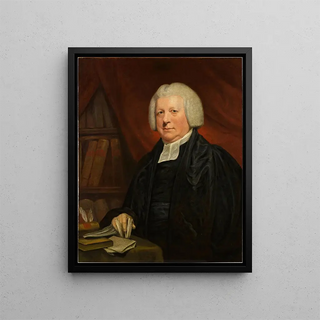Portrait of Reverend Samuel Glasse D.D. F.R.S. - John Hoppner Circle | Art print


View from behind

Frame (optional)
Portrait of Reverend Samuel Glasse D.D. F.R.S. - Circle of John Hoppner – Captivating Introduction
In the world of art, some works transcend their era to become timeless witnesses of history and culture. The art print of the portrait of Reverend Samuel Glasse D.D. F.R.S., created by the circle of John Hoppner, embodies this essence. This painting, which captures the spirit of a man of science and faith, immerses us in 18th-century England, a time when art and intellectual thought intertwined. Through this portrait, the artist does not merely depict an individual; he evokes a period, a milieu, and a worldview. Eyes meet, emotions are revealed, and the viewer is invited to explore the depths of the human soul while admiring the virtuosity of the pictorial technique.
Style and uniqueness of the work
The style of the Reverend Glasse's portrait is characteristic of the English school, where realism and idealization coexist harmoniously. Hoppner, known for his ability to capture the personality of his subjects, uses rich colors and subtle contrasts to bring his model to life. The details of the face, the folds of the clothing, and the light caressing the canvas testify to exceptional craftsmanship. This art print is not limited to a simple representation; it is a true ode to human dignity. The Reverend's posture, slightly inclined, and his contemplative gaze suggest a depth of character that invites reflection. Every brushstroke seems to tell a story, and each shade of color enhances the impression of life and authenticity.
The artist and his influence
John Hoppner, an emblematic figure of British portraiture, established himself as a master of his time. His career, marked by growing recognition, allowed him to mingle with the elite of English society, from aristocrats to intellectuals. Hoppner stands out for his ability to combine sensitivity and technique, offering portraits that go beyond mere physical representation. His influence is felt not only through his works but also by the impact he had on subsequent generations of artists. By choosing

Matte finish

View from behind

Frame (optional)
Portrait of Reverend Samuel Glasse D.D. F.R.S. - Circle of John Hoppner – Captivating Introduction
In the world of art, some works transcend their era to become timeless witnesses of history and culture. The art print of the portrait of Reverend Samuel Glasse D.D. F.R.S., created by the circle of John Hoppner, embodies this essence. This painting, which captures the spirit of a man of science and faith, immerses us in 18th-century England, a time when art and intellectual thought intertwined. Through this portrait, the artist does not merely depict an individual; he evokes a period, a milieu, and a worldview. Eyes meet, emotions are revealed, and the viewer is invited to explore the depths of the human soul while admiring the virtuosity of the pictorial technique.
Style and uniqueness of the work
The style of the Reverend Glasse's portrait is characteristic of the English school, where realism and idealization coexist harmoniously. Hoppner, known for his ability to capture the personality of his subjects, uses rich colors and subtle contrasts to bring his model to life. The details of the face, the folds of the clothing, and the light caressing the canvas testify to exceptional craftsmanship. This art print is not limited to a simple representation; it is a true ode to human dignity. The Reverend's posture, slightly inclined, and his contemplative gaze suggest a depth of character that invites reflection. Every brushstroke seems to tell a story, and each shade of color enhances the impression of life and authenticity.
The artist and his influence
John Hoppner, an emblematic figure of British portraiture, established himself as a master of his time. His career, marked by growing recognition, allowed him to mingle with the elite of English society, from aristocrats to intellectuals. Hoppner stands out for his ability to combine sensitivity and technique, offering portraits that go beyond mere physical representation. His influence is felt not only through his works but also by the impact he had on subsequent generations of artists. By choosing
12,34 €






